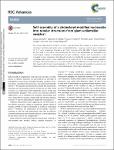Self-assembly of a cholesteryl-modified nucleoside into tubular structures from giant unilamellar vesicles
Losensky, Luisa
Chiantia, Salvatore
Holland, Gudrun
Laue, Michael
Petran, Anca
Liebscher, Jürgen
Arbuzova, Anna
We recently reported the formation of micro- and nanometer thick tubules in a binary system of cholesteryl-modified aminouridine and a phosphatidylcholine in aqueous solution upon cooling from 70 °C to room temperature (Pescador et al., Chem. Commun, 2010, 46, 5358). To better understand the first steps of the tubular self-assembly and the role of the phospholipid, we investigated now morphological changes of phosphatidylcholine giant unilamellar vesicles upon incorporation of the conjugate at room temperature. We observed formation of needle-like structures organized in rosettes or bundles within hours to days depending on the mole fraction of the conjugate and preparation technique. Transmission electron microscopy revealed that the needle-like structures were 100–200 nm thick tubules with the inner lumen diameters of 15–40 nm. The tube self-assembly occurred at room temperature, which is important for further development of biomedical applications.
Dateien zu dieser Publikation
Keine Lizenzangabe

